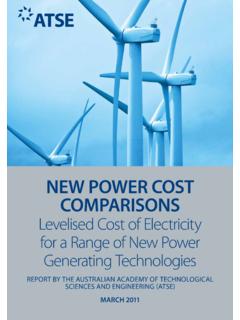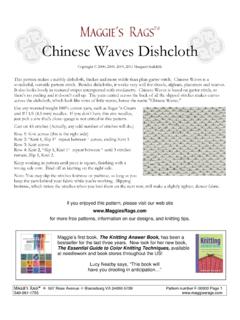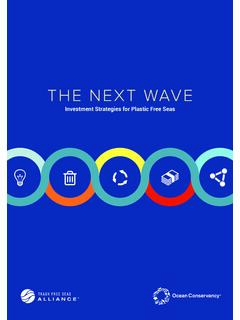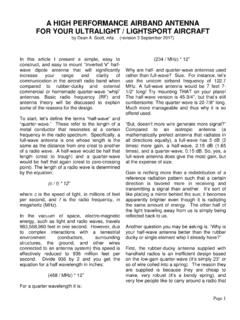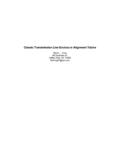Transcription of The potential of wave energy - Garnaut Climate Change …
1 The potential of wave energy Jenny Hayward and Peter Osman March 2011. Enquiries should be addressed to: Peter Osman CSIRO energy Transformed Flagship PO Box 330, Newcastle NSW 2300. Phone: +61-2-94905526. Email: Co p yrig h t a n d Dis c la im e r 2011 CSIRO To the extent permitted by law, all rights are reserved and no part of this publication covered by copyright may be reproduced or copied in any form or by any means except with the written permission of CSIRO. Im p o rta n t Dis c la im e r CSIRO advises that the information contained in this publication comprises general statements based on scientific research. The reader is advised and needs to be aware that such information may be incomplete or unable to be used in any specific situation.
2 No reliance or actions must therefore be made on that information without seeking prior expert professional, scientific and technical advice. To the extent permitted by law, CSIRO (including its employees and consultants) excludes all liability to any person for any consequences, including but not limited to all losses, damages, costs, expenses and any other compensation, arising directly or indirectly from using this publication (in part or in whole) and any information or material contained in it. Co n te n ts 1. Exe c u tive s u m m a 3. 2. In tro d u ctio n .. 4. 3. wa ve e n e rg y d e vic e s .. 4. Point Absorbers .. 4. Linear absorbers or attenuators .. 5. Terminators .. 6. 4. wa ve e n e rg y s ys te m s d e ve lo p m e n t a n d s tatus.
3 6. 5. Ec o n o m ic s of wa ve e ne rg y in Au s tra lia .. 7. 6. Co m p e tin g u s e s a n d en viro n m e n ta l im p a c ts .. 9. 7. How to re d u c e c o s t o f wa ve e n erg y? .. 9. Anchorage (Mooring and concrete) .. 10. Extreme events .. 11. Operations and 11. 8. Co n c lu s io n .. 12. Re fe re n c e s .. 13. i Lis t o f Fig u re s Figure 1: Pressure activated and heaving buoy point absorbers .. 5. Figure 2: Linear attenuator absorber (adapted from Pelamis schematic (Benson and Orr, 2008)).. 5. Figure 3: Tapered channel terminator .. 6. Figure 4: Point absorber levelised cost of electricity (LCOE) per annum map. The units on the scale are $/MWh .. 7. Figure 5: Linear attenuator LCOE per annum map.
4 The units on the scale are $/MWh .. 8. Figure 6: Terminator LCOE per annum map. The units on the scale are $ 8. Figure 7: Annual levelised cost of electricity breakdown (Data from R,Bedard ( , 2005)).. 10. Figure 8: Wave Dragon (overtopper) prototype with an overtopping wave Wavedragon ( , 2010) .. 11. Figure 9: Wave Dragon (overtopper) prototype showing tapered channel and ramp . Wavedragon ( , 2010) .. 12. ii EXECUTIVE SUMMARY. 1. EXECUTIVE S UMMARY. There is the potential for wave energy to make a contribution to the world's and Australia's electricity generation. There are more than 200 different wave energy convertors (WEC) in various stages of development. Research and development of WEC is centred in Europe and North America, with some activity in Australia.
5 The different types of WEC can be grouped into essentially three classes: point absorbers, attenuators and terminators. Point absorbers are small devices that extract wave energy from all directions. Attenuators are longer than the wavelength and extract wave energy through joints in the WEC. Overtoppers are large WEC that face directly into the wave. Using actual WEC and Australian resource data the levelised cost of electricity (LCOE). of wave energy in the Australian southern oceans has been calculated to be as low as ~100 $/MWh. There are various ways in which the LCOE of wave energy can be reduced. One of the major components of the cost is operations and maintenance, which does vary depending on the type of technology.
6 Another large cost is anchorage and one of the risks with wave energy is extreme waves . Devices need to be engineered to withstand these waves , whether by being massive or by being inexpensive enough that the financial loss is not too great. To supply at least 5% of Australia's total grid based electricity demand by 2050 it will be necessary for wave energy to generate 23 TWh. Depending on the technology, this will take up from 100km to 200km of coastline, segmented into a number of regions containing wave farms. This will raise issues, as with any energy technology there are competing-use and environmental concerns that need to be understood and alleviated. The potential of wave energy 3. INTRODUCTION.
7 2. INTRODUCTION. Two percent of the world's coastal waters have wave power densities that are great enough for extracting wave energy . This equates to 480 GW of power output or 4200. TWh/yr of electricity generation (Jacobson, 2009). Australia is fortunate to have much of the world's best resource along its Southern coastlines, where for example, the total wave energy crossing the 25 metre depth isobath between Geraldton and the Southern tip of Tasmania is over 1300 TWh/yr which is about five times the total electricity requirements of Australia (Hemer and Griffin, 2010). The potential to generate large amounts of electricity from wave energy has been known since the 1970's when the first wave energy demonstration devices were deployed.
8 After a long period of stagnation there is renewed interest in wave energy globally due to increasing awareness of Climate Change and specific country policies focussed on renewables to reduce carbon emissions. Australia's abundant wave energy resource combined with the global effort into wave energy has encouraged CSIRO to investigate the potential for ocean renewable energy in Australia. This report draws in part from a feasibility report that was developed as part of that research in early 2011 (CSIRO, 2011). There are currently at least 200 different wave energy devices in various stages of development and testing. Of these, about half a dozen have been scaled up and tested at sea with at least some of their test data published.
9 We have used the performance characteristics of three of these, matched to the wave Climate along Australia's south coast, as the basis for making assessments of the future market for ocean renewable energy in Australia. The report was prepared as input to the Garnaut Review Update in a relatively short time frame, and therefore is not intended to be comprehensive. 3. WAVE energy DEVICES. There are a great many techniques for extracting energy from ocean waves and numerous attempts have been made to categorise them. They can be broadly classified as: Point Absorbers', Linear Absorbers and Terminators. P o in t Ab s o rb e rs The term point absorber refers to devices that incorporate a float that is small compared to the swell wavelength.
10 The float is free to follow the movement of the wave and accept wave energy from any direction. It can be tethered so that it is submerged and moved by the pressure of the wave passing overhead, or it can float on the surface and track or heave' with the movement of the sea surface, as shown in Figure 1. 4. WAVE energy DEVICES. Figure 1: Pressure activated and heaving buoy point absorbers Lin e a r a b s o rb e rs o r a tte n u a to rs These devices incorporate a float, or a number of floats that are shaped or distributed to be aligned in the direction of wave travel. Their overall length may be large compared to the swell wavelength. However, they are also wavelength dependent. Unlike a point absorber they need to be slack moored so that they can turn to maintain their principal axis normal to the oncoming waves .

